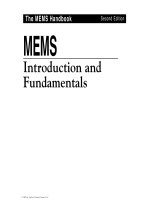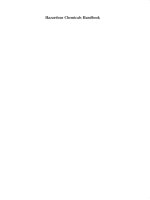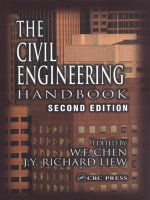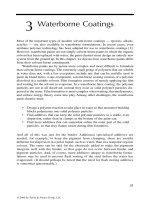Wine tasting a professional handbook second edition
Bạn đang xem bản rút gọn của tài liệu. Xem và tải ngay bản đầy đủ của tài liệu tại đây (6.94 MB, 519 trang )
Wine Tasting:
A Professional Handbook
Second Edition
Food Science and Technology
International Series
Series Editor
Steve L. Taylor
University of Nebraska – Lincoln, USA
Advisory Board
Ken Buckle
The University of New South Wales, Australia
Mary Ellen Camire
University of Maine, USA
Roger Clemens
University of Southern California, USA
Hildegarde Heymann
University of California – Davis, USA
Robert Hutkins
University of Nebraska – Lincoln, USA
Ron S. Jackson
Quebec, Canada
Huub Lelieveld
Bilthoven, The Netherlands
Daryl B. Lund
University of Wisconsin, USA
Connie Weaver
Purdue University, USA
Ron Wrolstad
Oregon State University, USA
A complete list of books in this series appears at the end of this volume.
Wine Tasting:
A Professional Handbook
Second Edition
Ronald S. Jackson
Cool Climate Oenology and Viticulture Institute, Brock University,
St. Catharines, Ontario, Canada
Academic Press is an imprint of Elsevier
30 Corporate Drive, Suite 400, Burlington, MA 01803, USA
525 B Street, Suite 1900, San Diego, California 92101-4495, USA
84 Theobald’s Road, London WC1X 8RR, UK
Copyright # 2009, Elsevier Inc. All rights reserved.
No part of this publication may be reproduced or transmitted in any form or by any
means, electronic or mechanical, including photocopy, recording, or any information
storage and retrieval system, without permission in writing from the publisher.
Permissions may be sought directly from Elsevier’s Science & Technology Rights
Department in Oxford, UK: phone: (þ44) 1865 843830, fax: (þ44) 1865 853333,
E-mail: You may also complete your request online
via the Elsevier homepage (), by selecting “Support & Contact”
then “Copyright and Permission” and then “Obtaining Permissions.”
Library of Congress Cataloging-in-Publication Data
APPLICATION SUBMITTED
British Library Cataloguing-in-Publication Data
A catalogue record for this book is available from the British Library.
ISBN: 978-0-12-374181-3
For information on all Academic Press publications
visit our Web site at www.elsevierdirect.com
Printed in the United States of America
09 10 9
8 7
6 5
4 3
2
1
Dedication
To my wife, Suzanne Ouellet
v
This page intentionally left blank
Table of Contents
PREFACE .............................................................................................xv
ACKNOWLEDGMENTS..........................................................................xix
ABOUT THE AUTHOR ..........................................................................xxi
CHAPTER 1
Introduction ..................................................................... 1
Tasting Process ...........................................................................1
Appearance ............................................................................4
Clarity ...............................................................................4
Color .................................................................................5
Viscosity ............................................................................6
Spritz ................................................................................6
Tears.................................................................................6
Odor ......................................................................................6
Orthonasal (in-glass) Odor...................................................6
In-mouth Sensations .............................................................14
Taste and Mouth-feel........................................................14
Odor—Retronasal .............................................................16
Finish ..................................................................................18
Overall Quality ..................................................................... 19
Postscript ............................................................................ 21
References ...............................................................................22
CHAPTER 2
Visual Perceptions.......................................................... 27
Color ........................................................................................27
Color Perception and Measurement........................................ 27
Significance in Tasting ......................................................... 32
Origin and Characteristics ..................................................... 34
Red Wines .......................................................................34
Rose´ Wines......................................................................40
White wines .....................................................................40
Clarity ......................................................................................41
Crystals ............................................................................... 41
Sediment............................................................................. 42
vii
viii
Table of Contents
Proteinaceous Haze .............................................................. 43
Phenolic Haze...................................................................... 43
Casse .................................................................................. 43
Deposits on Bottle Surfaces .................................................. 44
Microbial Spoilage................................................................ 44
Viscosity ...................................................................................45
Spritz .......................................................................................46
Tears........................................................................................48
Suggested Readings ..................................................................49
References ...............................................................................49
CHAPTER 3
Olfactory Sensations ....................................................... 55
Olfactory System .......................................................................56
Nasal Passages .................................................................... 56
Olfactory Epithelium, Receptor Neurons, and Cerebral
Connections .....................................................................58
Odorants and Olfactory Stimulation ............................................65
Chemical Compounds Involved ...................................................68
Acids................................................................................... 69
Alcohols .............................................................................. 69
Aldehydes and Ketones .........................................................69
Acetals ................................................................................ 70
Esters ..................................................................................70
Hydrogen Sulfide and Organosulfur Compounds...................... 71
Hydrocarbon Derivatives........................................................ 72
Lactones and Other Oxygen Heterocycles ............................... 73
Terpenes and Oxygenated Derivatives .....................................73
Phenolics ............................................................................ 74
Pyrazines and Other Nitrogen Heterocyclics............................ 75
Sensations from Trigeminal Nerve ..............................................75
Vomeronasal Organ....................................................................76
Odor Perception ........................................................................77
Sources of Variation in Olfactory Perception ................................87
Odor Assessment in Wine Tasting ...............................................97
Off-Odors..................................................................................98
Acetic Acid (Volatile Acidity) ................................................. 99
Baked ................................................................................. 99
Buttery ................................................................................ 99
Corky/Moldy ......................................................................... 99
Ethyl Acetate ..................................................................... 100
Ethyl Phenols..................................................................... 100
Table of Contents
Fusel................................................................................. 101
Geranium-like .................................................................... 101
Light Struck....................................................................... 101
Mousy ............................................................................... 101
Oxidation ........................................................................... 102
Reduced-Sulfur Odors......................................................... 103
Sulfur Odor........................................................................ 104
Untypical Aging Flavor (untypischen Alterungsnote, UTA)...... 104
Vegetative Odors ................................................................ 104
Other Off-Odors.................................................................. 105
Chemical Nature of Varietal Aromas......................................... 105
Suggested Readings ............................................................... 111
References ............................................................................ 112
CHAPTER 4
Taste and Mouth-Feel Sensations .................................. 129
Taste..................................................................................... 130
Sweet, Umami, and Bitter Tastes ........................................ 135
Sour and Salty Tastes (ASIC and ENaC Channels) ................ 138
Factors Influencing Taste Perception ....................................... 140
Physicochemical ................................................................ 140
Chemical ........................................................................... 141
Biologic ............................................................................. 143
Psychologic........................................................................ 145
Mouth-Feel ............................................................................ 146
Astringency ........................................................................147
Burning..............................................................................151
Temperature.......................................................................151
Prickling ............................................................................152
Body (Weight).....................................................................153
Metallic .............................................................................154
Chemical Compounds Involved ................................................ 154
Sugars ...............................................................................154
Alcohols.............................................................................155
Acids................................................................................. 156
Phenolics ...........................................................................157
Polysaccharides ................................................................. 162
Nucleic Acids .................................................................... 162
Taste and Mouth-Feel Sensations in Wine Tasting .................... 163
Appendix 4.1: Measuring Taste Bud Density ............................ 164
Suggested Readings ............................................................... 165
References ............................................................................ 166
ix
x
Table of Contents
CHAPTER 5
Quantitative (Technical) Wine Assessment ..................... 177
Selection and Training of Tasters............................................. 182
Basis Requirements............................................................ 182
Identification of Potential Wine Panelists ............................. 186
Testing and Training........................................................... 187
Basic Selection Tests .....................................................190
Taste Recognition...................................................... 190
Taste Acuity ..............................................................190
Relative Sensitivity (Sweetness)..................................192
Threshold Assessment................................................193
Odor Recognition Tests ...................................................195
Fragrance (Aroma and Bouquet) ................................. 195
Off-Odors: Basic Test................................................. 195
Off-Odors in Different Wines ...................................... 197
Discrimination Tests .......................................................197
Varietal Dilution ........................................................ 197
Varietal Differentiation............................................... 199
Short-Term Wine Memory........................................... 201
Taster Training...............................................................202
Assessing Taster and Panel Accuracy................................... 203
Score Variability .............................................................205
Summary ........................................................................... 208
Pre-Tasting Organization ......................................................... 208
Tasting Area ...................................................................... 208
Number of Samples............................................................ 212
Replicates ......................................................................... 213
Temperature ...................................................................... 213
Cork Removal..................................................................... 215
Decanting and Pouring ....................................................... 215
Sample Volume .................................................................. 216
Dispensers ......................................................................... 216
Representative Samples...................................................... 216
Glasses.............................................................................. 217
Number of Tasters.............................................................. 220
Tasting Design ....................................................................... 221
Information Provided .......................................................... 221
Preparing Samples ............................................................. 222
Sources of Perceptive Error ................................................. 222
Timing............................................................................... 225
Wine Terminology................................................................... 226
Wine Evaluation ..................................................................... 233
Table of Contents
Score Sheets...................................................................... 233
Statistical Analysis ............................................................. 242
Simple Tests..................................................................244
Multivariate Techniques..................................................247
Pertinence of Tasting Results ..........................................250
Sensory Analysis .................................................................... 250
Discrimination Testing ........................................................ 251
Scaling Tests ..................................................................... 253
Descriptive Sensory Analysis ............................................... 256
Time-Intensity (TI) Analysis................................................. 268
CHARM Analysis ................................................................ 271
Finger Span Cross Modality (FSCM) Matching ...................... 271
Chemical Measures of Wine Quality ......................................... 272
Standard Chemical Analyses ............................................... 272
Electronic Noses ................................................................ 274
Occupational Hazards of Wine Tasting ..................................... 278
Suggested Readings ............................................................... 290
References ............................................................................ 291
CHAPTER 6
Qualitative Wine Assessment......................................... 303
Tasting Room......................................................................... 304
Information Provided .............................................................. 305
Sample Preparation ................................................................ 305
Decanting and Breathing..................................................... 305
Temperature ...................................................................... 308
Glasses.............................................................................. 309
Sample Number and Volume ............................................... 310
Cork Removal..................................................................... 311
Palate Cleansing ................................................................ 312
Language........................................................................... 313
Wine Score Sheets ................................................................. 317
Sensory Training Exercises ...................................................... 319
Staff Training for Medium to Small Wineries ........................ 320
Tasting Situations .................................................................. 322
Wine Competitions ............................................................. 322
Consumer Preference Tastings............................................. 324
Trade Tastings ................................................................... 327
In-store Tastings ................................................................ 328
Wine Appreciation Courses.................................................. 329
Wine Tasting Societies........................................................ 333
Home Tastings ................................................................... 336
xi
xii
Table of Contents
Appendices............................................................................ 337
Suggested Readings ............................................................... 344
References ............................................................................ 345
CHAPTER 7
Styles and Types of Wine .............................................. 349
Still Table Wines .................................................................... 351
White Cultivars................................................................... 353
Red Cultivars ..................................................................... 354
Production Procedures........................................................ 356
Prior to Fermentation......................................................356
During Fermentation.......................................................360
After Fermentation .........................................................361
White Wine Styles .............................................................. 362
Red Wine Styles................................................................. 366
Rose´ Wine Styles ............................................................... 371
Sparkling Wines ..................................................................... 372
Fortified Wines (Dessert and Appetizer Wines).......................... 377
Sherry................................................................................379
Port................................................................................... 381
Madeira ............................................................................. 384
Vermouth........................................................................... 384
Brandy .................................................................................. 384
Suggested Readings ............................................................... 385
References ............................................................................ 385
CHAPTER 8
Nature and Origins of Wine Quality................................ 387
Sources of Quality .................................................................. 390
Vineyard Influences ................................................................ 391
Macroclimate ..................................................................... 392
Microclimate...................................................................... 392
Species, Variety, and Clone................................................. 395
Rootstock .......................................................................... 396
Yield ................................................................................. 398
Training............................................................................. 400
Nutrition and Irrigation ....................................................... 401
Disease ............................................................................. 402
Maturity............................................................................. 402
Winery................................................................................... 403
Winemaker ........................................................................ 403
Prefermentation Processes .................................................. 404
Fermentation ..................................................................... 406
Table of Contents
Fermentor......................................................................406
Yeasts ...........................................................................407
Lactic Acid Bacteria .......................................................407
Postfermentation Influences................................................ 410
Adjustments ..................................................................410
Blending........................................................................410
Processing .....................................................................411
Oak ...............................................................................411
Bottle Closure ................................................................413
Aging ............................................................................414
Aging Potential ..............................................................418
Chemistry .............................................................................. 420
Suggested Readings ............................................................... 422
References ............................................................................ 422
CHAPTER 9
Wine and Food Combination.......................................... 427
Introduction ........................................................................... 427
Wine Selection....................................................................... 435
Historical Origins of Food and Wine Combination...................... 436
Concept of Flavor Principles.................................................... 439
Food and Wine Pairing............................................................ 440
Uses in Food Preparation ........................................................ 448
Basic Roles........................................................................ 448
Involvement in Food Preparation ......................................... 449
Types of Occasions................................................................. 450
Wine Presentation .................................................................. 450
Presentation Sequence ....................................................... 450
Cellaring............................................................................ 452
Glasses.............................................................................. 453
Serving Temperature........................................................... 454
Breathing........................................................................... 454
Wine Preservation after Opening.......................................... 454
Label Removal ................................................................... 457
Final Note ............................................................................. 458
Suggested Readings ............................................................... 458
References ............................................................................ 459
GLOSSARY ....................................................................................... 465
INDEX .............................................................................................. 473
xiii
This page intentionally left blank
Preface
Wine tasting means different things to different people. For this text, it
primarily refers to critical wine assessment. Thus, it attempts to differentiate between perception (the human response to sensation) and sensation
itself. It is searching for tangible reality. Training and experience are usually
required to separate subjective response from objective evaluation. Usually,
however, wine tasting is more concerned with the perception of reality.
That is what sells wine. Thus, most wine tastings are conducted under conditions that favor positive assessment. This is not a criticism but a reflection of the diverse functions of wine tasting. Each has its purpose and
merit, with none being inherently more appropriate than another.
Winemakers have their particular interests in wine tasting: facilitating
wine production in a particular style and checking for sensory defects before
they become serious or irreversible. Wholesalers and retailers are interested
in selecting wines that suit the desires of their clients and in avoiding faulty
wines. For most connoisseurs, tasting wine is intended to enhance appreciation, either by itself or in combination with food. This is the clientele for
whom most boutique or premium wine producers aim their products. For
even a larger group of individuals, notably in Europe, wine is simply the
standard food beverage – tasting with discernment being reserved for special
occasions. For others, wine consumption is a status symbol or an affirmation of cultural heritage. Although the thrust of this text is scientific,
selected sections can be used by any wine taster. Correspondingly, applied
aspects are noted separately to facilitate their use by those less interested
in tasting’s academic aspects.
In addition to differences in how people interpret wine tasting, the term
taste has multiple meanings. Technically it refers to specific chemosenses
detected by modified epithelial cells located in taste buds. In common
usage, however, it incorporates the somatosensory sensations of mouth-feel
and olfaction. As a verb, it refers to the process of sampling beverages and
foods, usually in a conscious assessing mode. The terms “organoleptic”
and “degustation” specifically refer to aspects of this process, but for various
reasons have not been espoused in either the scientific or popular literature.
xv
xvi
Preface
The complexities surrounding the terms “taste” and “tasting” underscores a fundamental duality. Gustatory, olfactory and mouth-feel
sensations, as well as associated visual and auditory sensations are
derived from different physical locations. However, the responses, initially analyzed in distinct areas of the brain, are combined and integrated
for final interpretation in a central location – the orbitofrontal cortex.
These multisensory perceptions, and the memory traces they encrypt,
generate what is termed “flavor.” It is a cerebral construct. Examples
of this illusion are the sweet “taste” of many fruity odors, the “loss” of
flavor from gum as its sugar content declines, and the “nutty” aspect
of cracked-wheat bread. The association with intake probably explains,
at least partially, why the brain “locates” flavor as originating in the
mouth and with “tasting.”
The techniques described are primarily designed for professional tasters
– those involved in assessing wine attributes, relative quality, or conformity
to traditional varietal or regional styles. These skills are required not only
for critical wine evaluation, but also for successful wine making. Although
analytic, these procedures can be adapted by the restaurateur or wine merchant, as well as individuals desiring to fully appreciate a wine’s sensory
attributes.
Small wineries rarely employ the detailed sensory evaluation procedures
noted in the text. Their wines are produced “on the palate of the winemaker”—the wine being considered a creative, artisanal product, not
designed for a mass market. Their wines sell because sufficient customers
accept the winemaker’s perceptions. It also helps that most consumers are
not particularly discriminating or demanding. Customers are often easily
persuaded by the opinions of others. This is not a disparaging comment
on consumers or small wineries, just an affirmation of reality. Some small
wine estates produce absolutely superior wines and their winemakers are
exceptionally skilled. The same procedures, in less competent hands, can
produce eminently forgettable wines. The situation is quite different for
large wineries. Their wines are sold internationally, produced in millionliter plus quantities, face extensive and stiff competition, and are sold continents away from any personal contact with the winery staff. Successful
brands are created using selective blending techniques that require the use
of some of the most sensitive and critical sensory evaluation procedures
available. Millions of dollars and shareholder profits ride on the decisions
made not only by grape growers, winemakers, marketers, but also sensory
evaluation experts. There is little margin for personal error. Quality control
is critical.
Preface
In the text, the reader is first guided through the steps of wine tasting. Subsequently, the psycho-physical and neuroanatomical aspects of sensory
response are discussed. This is followed by a discussion of the optimal
conditions for wine assessment and evaluation, the selecting and training of
judging ability, preparing various types of tastings, and the analysis of
significance. Wine classification and the origins of wine quality are covered
with a discussion of what can confidently be said about wine and food pairing.
Although significant strides in our understanding of sensory perception
have occurred in the past few years, it is also becoming clear that perception is relative, with few absolutes. What individuals perceive depends not
only on their genetics, but also on their upbringing, current emotional and
physical health, and the context in which the tasting occurs. Within limits,
the latter can be more important to perception than the quality of the wine.
Dogmatism concerning wine quality is as obsolete as the model-T Ford.
Because of historical and cultural connections between food and wine,
and its popularity among wine afficionados, the topic has received more
extensive expansion and revision than any other chapter. Despite this,
the best wines usually express their finest qualities more clearly when
sampled in the absence of food. For example, the development and finish
of a wine are seldom detectable when consumed with food. The time
required for their expression rarely being available or appropriate during a
meal. To facilitate their detection, wine afficionados often analyze fine table
wines prior to eating, or consume the wine slowly and conscientiously with
simply prepared food (minimal flavoring). Aperitif and dessert wines are
more amenable to full appreciation as they are frequently taken alone.
As with the appreciation of other art forms, the feeling of status and
well-being, associated with sampling fine wines with delicately and exquisitely prepared food, is its primary appeal. This is especially evident in
the elaborate surroundings of fine dining establishments. This is one of
the advantages of surplus income, where the pleasures of eating can be
divorced from simply abating hunger pangs. In addition, pairing wine with
food helps avoid monotony at the table. Except where the suggestions of
experts are followed slavishly, just the act of wine selection can give
pleasure and a sense of intrigue.
Wine can act as a wonderful accompaniment to a meal, helping to
cleanse the palate while providing a distinct and gratifying sensation, and
elevate mealtime to a sublime celebration of life. In turn, food freshens
the palate to receive anew the flavors of the wine. Compatibility rests
primarily in their differences, not on their similarities. In this regard, wine
can be considered a food condiment. Correspondingly, a central tenet of
xvii
xviii
Preface
food and wine combination is that the attributes of the wine should neither
clash with the food, nor be excessively mild or intense, in comparison with
the predominant food flavors. This is all, of course, based on the flavor sensitivities of the individual, and acceptance of the concept of balance as desirable in wine and food combination. Although an interesting and endless
topic of conversation, undue concern about pairing can overshadow what
should be a pleasurable and relaxed occasion to nourish the body as well
as the soul.
Hopefully, the information contained herein will give the reader the
ability to strip away the influences of context and experience that too often
afflict wine tasting, precluding valid and fair assessments. As often as not,
you should question your own perceptions as much as the views of others.
Investigations have clearly demonstrated how powerful expectation or
suggestion can be, not only on the higher cognitive centers of the brain,
but also on how they impact the responsiveness of receptor neurons. Knowing how the brain can potentially “deceive” us gives us the power to select
what contextual or experience-based influences we permit to affect perception. It is always better to be in the driver’s seat than to be driven.
References included in the text are provided as a guide to further investigation, rather than attempting to be all-inclusive. Suggested Readings
supply a list of major texts and reviews.
If anything, I hope that from time to time you will relax and fully
contemplate the sensory intricacies of wine and how they can complement
a meal. They can embellish our short span on this small speck of the universe with wonders that make life fully worth living.
R. S. Jackson
Acknowledgments
Without the dedication of innumerable researchers, the complexities of
human sensory acuity and perception would remain mysteries and this
book would have been impossible.
Many thanks go to my students, participants of sensory panel tests,
MLCC External Tasting Panel, the Manitoba Liquor Control Commission
and Academic Press for providing the opportunity to gain access to both
the practical and theoretical sides of wine assessment.
Finally, but certainly not least, I must express my thanks to the assistance provided by staff at Elsevier, notably Nancy Maragioglio and Christie
Jozwiak. Their help and encouragement have been critical in bringing this
book to fruition.
xix
This page intentionally left blank
About the Author
Ronald S. Jackson received his bachelor’s and master’s degrees from
Queen’s University, and doctorate from the University of Toronto. His sabbatical at Cornell University redirected his academic interest toward viticulture and enology. While professor and chair of the Botany Department,
Brandon University, he developed the first wine technology course in
Canada. For many years he was a technical advisor to the Manitoba Liquor
Control Commission, developing sensory evaluation tests to train and
assess members of its Sensory Panel. He was also a long-time member of
the MLCC External Tasting Panel. In addition to preparing this book, he
is author of Wine Science: Principles and Applications, 3e (2008), Conserve
Water Drink Wine (1997), several technical reviews, and annual articles in
Tom Stevenson’s The Wine Report. Dr. Jackson has retired from teaching
to devote his time to writing, but remains allied with the Cool Climate
Oenology and Viticulture Institute, Brock University. He may be reached
at Elsevier, 525 B Street Suite 1900, San Diego, CA 92101-4495.
xxi
This page intentionally left blank
CHAPTER 1
Introduction
CHAPTER CONTENTS
Tasting Process
Appearance
Odor
In-mouth Sensations
Finish
Overall Quality
Postscript
1
4
6
14
18
19
21
As befits one of life’s finest pleasures, wine deserves serious attention.
Nevertheless, no wine tasting procedure has achieved universal adoption.
Most experienced wine tasters have their own preferred procedure.
Although essential for critical tasting, those described here are too detailed
for the dinner table. The difference is equivalent to score analysis versus
music appreciation. Critical tasting compares one or several wines against
a real or theoretical standard. In contrast, wine with a meal is intended to
be savored as a liquid refreshment. Although critical wine assessment is
ill designed for the dining room, due to the distractions of conversation
and the interference of food flavors, the concentration involved in wine
analysis can greatly enhance appreciation.
TASTING PROCESS
The technique discussed here (Fig. 1.1) is a synopsis of experience gained
from assessing tasters, but is a reasonable starting point. No technique is
ideal for everyone. Probably the most essential property of a serious taster
is the willingness, desire, and ability to focus his or her attention on the
wine’s characteristics.
Peynaud (1987) advocates rinsing the mouth with wine before embarking
on serious tasting. Where tasters are unfamiliar with the characteristics of the
Wine Tasting: A Professional Handbook, Second Edition
Copyright # 2009 by Academic Press, Inc. All rights of reproduction in any form reserved.
1
2
C H A P T E R 1 : Introduction
FIGURE 1.1
Sequence of wine tasting.









